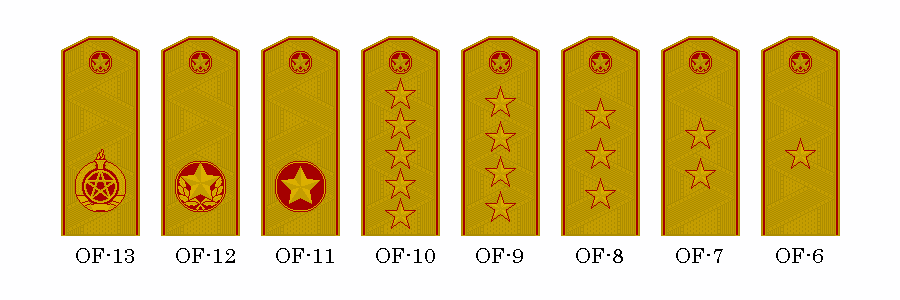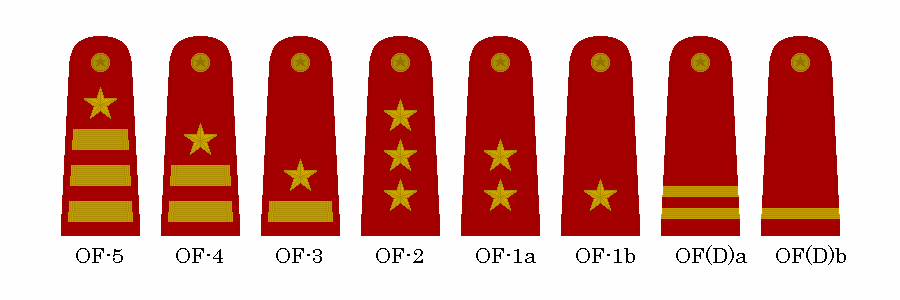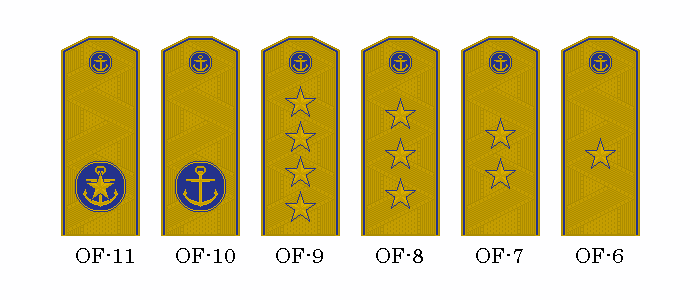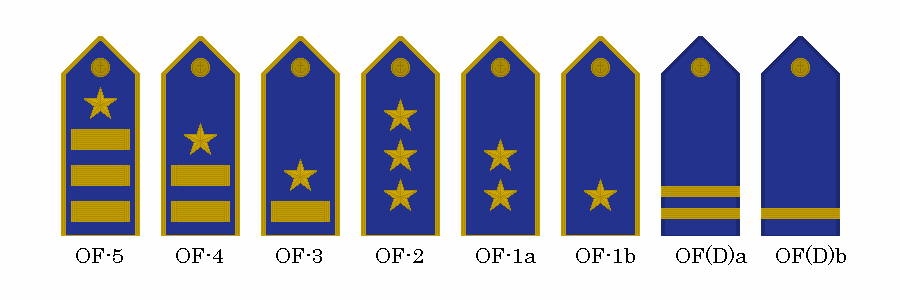Military ranks of Menghe
The military ranks of Menghe follow a basic structure which is shared between the Army, the Navy, and certain organs of the Ministry of Internal Security. Menghe lacks an administratively independent air force branch, but personnel of Army Aviation and Naval Aviation wear slightly different insignia from their surface counterparts.
All rank insignia are worn on shoulder straps, with rigid shoulder boards for dress uniforms and slip-on rank slides for field uniforms. Collar and lapel insignia differ by grade, but not by individual rank, with different markers for enlisted personnel, NCOs, junior officers, field officers, generals, and marshals.
History
Army ranks
General-grade ranks
Ranks OF-6 through OF-13 in the Menghean Army are known as general-grade ranks, or sometimes in Anglian as flag officer ranks, though it is not standard practice in the Menghean Army to fly a special flag over a General's position so the translation is only conceptual. Personnel in these ranks are entitled to more privileges than the commissioned officers below them, and wear a different dress uniform.
The Menghean Army is noteworthy for its large number of general-grade ranks, running all the way to OF-13. This is partly due to a forced distinction between generals, who are assigned to command positions, and marshals, who are assigned to administrative positions. The five-star sangjang rank designates the commander of an Army Group, and currently five individuals hold this position. Vice Marshals are tasked with leading specific departments and services, resulting in a Vice Marshal for the Artillery Forces, a Vice Marshal for Aviation, and so on. Marshal is the highest rank in the Menghean Army proper, given to the Supreme Commander of the Army and all retired persons who have held this position.
Supreme Marshal (Dae Wŏnsu) is a rank which Choe Sŭng-min created following his self-coup of March 1st 1988, to more firmly establish his authority over the higher-ranking officers in the Armed Forces. Until then, he had held the rank of Major General. Supreme Marshal is an all-branch rank, meaning that it concurrently represents the highest post in the Navy officer hierarchy, and it is associated with Choe's administrative post as Supreme Commander of the Armed Forces. After Choe Sŭng-min passed away in 2021, no other officers were promoted to the rank of Dae Wŏnsu, with Kang Yong-nam retaining his rank of Marshal when promoted to Supreme Commander of the Armed Forces.
Since 2007, all general-grade ranks have used a stitched, patterned gold background, with gold stars outlined in red. Marshal-grade ranks use an Army star without oak leaves for the Vice Marshal, an Army star with oak leaves (as on the flag of the Menghean Army for the Marshal, and the national emblem for Supreme Marshal, all in a red-and-gold color scheme. When a general or marshal is visiting the front lines in a field uniform, a low-visibility version mimicking the former "stars and bars" General insignia may be used.
| Level | Marshal-grade officers | General-grade officers | ||||||
|---|---|---|---|---|---|---|---|---|
| Standard rank code | OF-13 | OF-12 | OF-11 | OF-10 | OF-9 | OF-8 | OF-7 | OF-6 |
| Menghean name | 大元帥 대원수 |
元帥 원수 |
次帥 차수 |
大將 대장 |
上將 상장 |
中將 중장 |
少將 소장 |
準將 준장 |
| Transliteration | Dae Wŏnsu | Wŏnsu | Chasu | Daejang | Sangjang | Jungjang | Sojang | Junjang |
| Official translation | Supreme Marshal | Marshal | Vice Marshal | High General | General | Lieutenant General | Major General | Brigadier General |
Commissioned ranks
The Menghean Army distinguishes between General-grade officers and regular commissioned ranks, which consist of field-grade and junior-grade officers. Officer cadets are also included in this category. The international equivalent ranks run from OF(D) to OF-5. Commissioned officers in this rank wear different dress uniforms from general-grade officers and enjoy more limited privileges.
All non-flying commissioned officers in the Menghean Army are volunteers or re-enlisting conscripts, and all undergo four years of training at the Menghean National Defense Academy, a large training and instruction complex located in Donggyŏng. At the MNDA, all cadets bear the rank of sagwan huboasaeng. The rank of sagwan haksaeng is given to cadets in the Gundae Hakgyo system. Not all GH students enroll in the MNDA, and not all MNDA entrants are GH graduates, so some sources consider sagwan haksaeng to be a largely symbolic rank functionally separate from the Menghean Army's formal rank system, even though Menghean Army uniform and saluting regulations cover it.
On their dress uniforms, commissioned officers and officer candidates wear dark red shoulder boards with rank insignia in gold. On field uniforms, the same insignia are stitched in dull gold on a drab background and worn in removable sleeves on the uniform's shoulder straps. Low-visibility shoulder insignia for commissioned officers were among the earliest changes made in the 2005 Menghean military reforms.
| Level | Field-grade officers | Junior-grade officers | Officer cadets | |||||
|---|---|---|---|---|---|---|---|---|
| Standard rank code | OF-5 | OF-4 | OF-3 | OF-2 | OF-1a | OF-1b | OF(D)a | OF(D)b |
| Menghean name | 大領 대령 |
中領 중령 |
少領 소령 |
大尉 대위 |
中尉 중위 |
少尉 소위 |
士官候補生 사관 후보생 |
士官學生 사관 학생 |
| Transliteration | Daeryŏng | Jungryŏng | Soryŏng | Daewi | Jungwi | Sowi | Sagwan Hubosaeng | Sagwan Haksaeng |
| Official translation | Colonel | Lieutenant Colonel | Major | Captain | Senior Lieutenant | Junior Lieutenant | Officer Candidate | Student Officer |
Enlisted ranks
Enlisted ranks are divided into two groups: "non-commissioned officer" and "enlisted without commission." When the enlisted rank system was created in 1901, there were three NCO ranks ending in sa (士/사) and three regular enlisted ranks ending in byŏng (兵/병). Byŏngjang (sergeant) was created in 1910 and originally had a four-bar rank insignia; this was changed to a star in 1919, when it was reclassified as an NCO position. Tŭkmusangsa (sergeant major), created in 1990, is a position for the division's highest NCO, who carries the divisional standard in parades. Regular enlisted personnel can be either conscripts or volunteers, but as a rule, since 2005 all NCOs have been volunteers or re-enlisting conscripts and all have completed a special NCO training course.
Recruits in training are given the rank of hunryŏnbyŏng, or "trainee." The two-bar rank of idŭngbyŏng has also been translated as Specialist and Efreiter, and normally denotes a soldier trained on a special weapon system, such as a sharpshooter, ATGM operator, or tank gunner. Conscripts who re-enlist as volunteers after completing their two-year mandatory term are automatically granted the rank of idŭngbyŏng, even if assigned as a rifleman, though direct volunteers must still serve two years as an ildŭngbyŏng, unless trained as a specialist.
The rank of sangdŭngbyŏng (literally, "upper-level soldier") originally denoted the most senior enlisted soldier in the squad, and was not a command position. In the 1930s, it became standard practice for the sergeant to assign a group of riflemen to act as a separate maneuver unit under the direction of the sangdŭngbyŏng, making the position similar in function to a corporal, but personnel in this rank did not receive additional officer training and were not treated as NCOs. Promotion was often done at the sergeant's discretion. This practice persisted up to 2005, when as part of Menghe's military restructuring the rank was officially granted NCO status with a special fireteam-leader training course. The suffix rank name and three-bar insignia were both retained, even though it was no longer part of the regular enlisted rank series.
Sangdŭngbyŏng, ildŭngbyŏng, and idŭngbyŏng are regularly shortened to sangbyŏng, ilbyŏng, and ibyŏng in conversation, and tŭkmusangsa is regularly shortened to tŭksa. Current regulations state that the long form must be used on written documents but the short form must be used when addressing a soldier vocally.
All enlisted rank insignia use red insignia on the base color of the uniform. On dress uniforms, they are stitched directly onto the olive drab shoulder strap, while on field uniforms they are worn on removable sleeves that fit onto the shoulder strap.
| Level | Non-commissioned officers | Enlisted personnel without commission | |||||||
|---|---|---|---|---|---|---|---|---|---|
| Standard rank code | OR-9 | OR-8 | OR-7 | OR-6 | OR-5 | OR-4 | OR-3 | OR-2 | OR-1 |
| Menghean name | 特務上士 특무상사 |
上士 상사 |
中士 중사 |
下士 하사 |
兵長 병장 |
上等兵 상등병 |
一等兵 일등병 |
二等兵 이등병 |
訓鍊兵 훈련병 |
| Transliteration | Tŭkmusangsa | Sangsa | Jungsa | Hasa | Byŏngjang | Sangdŭngbyŏng | Ildŭngbyŏng | Idŭngbyŏng | Hunryŏnbyŏng |
| Official translation | Sergeant Major | Master Sgt. | Sgt. 1st Class | Staff Sgt. | Sergeant | Corporal | Private 1st Class | Private | Recruit |
The rank system of the Menghean Navy is based loosely on that of the Imperial Menghean Navy, which was disbanded after the Pan-Septentrion War. Nevertheless, changes made after the Navy's resurrection in 1964 resulted in a convergence with the Army's rank system, particularly in the commissioned ranks.
Notably, while the official Anglian translations used internationally adopt common naval terminology, the Menghean language makes no distinction between Army and Navy titles among the commissioned ranks. Thus a Major in the Army and a Lieutenant-Commander in the Navy are both Soryŏng. For clarity, the Navy ranks are usually preceded by Haegun ("Navy") in written documents, but this is dropped when addressing an officer. Conversely, while in Anglian "Captain" can refer either to the OF-5 rank or to the commander of the ship, no such ambiguity exists in Menghean; a "captain" in the latter sense is either a hamjang (艦長 / 함장) or sŏnjang (船長 / 선장) regardless of rank.
Flag-grade ranks
The Menghean Navy has four Admiral-grade flag officer ranks and two "special" marshal-level ranks. From the 1960s up to the 1990s, the rank of Haegun Daejang had a five-star shoulder board and an OF-10 position, but High Admiral Sang Yŏng-ho insisted in 1998 that it be given a special insignia so that the Admiral of the Fleet would be equivalent in rank to the Marshal of the Army. A Vice Admiral of the Fleet rank was also created, though it was not filled until 2003. In 2008 the Army restored the five-star rank of Daejang between Chasu and Sangjang, meaning that in theory the Admiral of the Fleet is one rank below the Marshal of the Army. The National Assembly has thus far ignored calls for a revision of the Navy's flag officer ranks, though standard practice holds that as Marshals and Vice Marshals are a separate level from General-grade flag officers, they may address each other as equal-ranks.
Admirals in the Menghean Navy are true "flag officers," in that a special pennant is flown from a ship's mast when they are on board and in command. These pennants have either one, two, three, or four blue stars arranged in a horizontal line on a white background. They are only flown from ships, not from small launches or buildings on land. The pennants of the Admiral of the Navy and Vice Admiral of the Navy use their respective shoulder-board insignia in place of stars.
| Level | Marshal-grade officers | Admiral-grade officers | ||||
|---|---|---|---|---|---|---|
| Standard rank code | OF-11 | OF-10 | OF-9 | OF-8 | OF-7 | OF-6 |
| Menghean name | 海軍元帥 해군 원수 |
海軍次帥 해군 차수 |
海軍上將 해군 상장 |
海軍中將 해군 중장 |
海軍少將 해군 소장 |
海軍準將 해군 준장 |
| Transliteration | Haegun Wŏnsu | Haegun Chasu | Haegun Sangjang | Haegun Jungjang | Haegun Sojang | Haegun Junjang |
| Official translation | Admiral of the Navy | Vice-Admiral of the Navy | Admiral | Vice Admiral | Rear Admiral | Commodore |
Commissioned ranks
The current rank structure of Menghean Navy commissioned officers was adopted directly from that of the Menghean Army in 1965, after the Menghean People's Navy was re-established. The rank insignia are also identical to those on Army commissioned officers' shoulder-boards, but with an azure background and gold trim on a pentagonal base.
As in the Army, Haegun Sagwan Hubosaeng is the cadet rank used by trainees at the Menghean Naval Academy in Sunju, while Haegun Sagwan Haksaeng is the cadet rank used by high-school-level students in the Navy's Gundae Hakgyo schools. The latter are not technically considered Navy personnel, but guidelines on uniform style and saluting include them alongside cadets in regulations.
| Level | Field-grade officers | Junior-grade officers | Officer cadets | |||||
|---|---|---|---|---|---|---|---|---|
| Standard rank code | OF-5 | OF-4 | OF-3 | OF-2 | OF-1a | OF-1b | OF(D)a | OF(D)b |
| Menghean name | 海軍大領 해군 대령 |
海軍中領 해군 중령 |
海軍少領 해군 소령 |
海軍大尉 해군 대위 |
海軍中尉 해군 중위 |
海軍少尉 해군 소위 |
海軍士官候補生 해군 사관 후보생 |
海軍士官學生 해군 사관 학생 |
| Transliteration | Haegun Daeryŏng | Haegun Jungryŏng | Haegun Soryŏng | Haegun Daewi | Haegun Jungwi | Haegun Sowi | Haegun Sagwan Hubosaeng | Haegun Sagwan Haksaeng |
| Official translation | Captain | Commander | Lieutenant Commander | Senior Lieutenant | Junior Lieutenant | Ensign | Officer Candidate | Student Officer |
Enlisted ranks
Of all its rank groups, the enlisted ranks of the Menghean Navy differ most clearly from those of the Army. While the Army divides enlisted personnel into NCOs and non-officers, the Navy has three categories of enlisted personnel, each with three ranks. Like the Army, the Navy does staff all NCO positions with volunteers and re-enlisting conscripts, directing first-time conscripts to regular service ranks where high turnover takes a smaller toll on acquired skill.
The highest of the Navy's rank trios, spanning OR-7 through OR-9, functions similarly to warrant officers in other militaries. Personnel holding these ranks are generally more senior NCOs who have acquired long-term experience in a particular position, and they come with longer-term billets to preserve that experience. The modernization of the Menghean Navy has been marked by a greater reliance on officers in these ranks, both to handle more advanced onboard equipment and to pass on expertise to other crew members.
The image below shows the insignia as they appear on the Navy's "summer uniform," which is used year-round on the South Menghe Sea. The "winter uniform" uses a black shirt and black trousers, and therefore the navy blue insignia are outlined with white stitching to improve contrast. The same white outline is present on submariner uniforms, which use a blue shirt year-round. Fire-resistant work coveralls use the white insignia on a blue-gray background.
| Level | Warrant officers | Non-commissioned officers | Seamen | ||||||
|---|---|---|---|---|---|---|---|---|---|
| Standard rank code | OR-9 | OR-8 | OR-7 | OR-6 | OR-5 | OR-4 | OR-3 | OR-2 | OR-1 |
| Menghean name | 上等海曹 상등 해조 |
一等海曹 일등 해조 |
二等海曹 이등 해조 |
海軍上士 해군 상사 |
海軍中士 해군 중사 |
海軍下士 해군 하사 |
海軍一等兵 해군 일등병 |
海軍二等兵 해군 이등병 |
海軍訓鍊兵 해군 훈련병 |
| Transliteration | Sangdŭng Haejo | Ildŭng Haejo | Idŭng Haejo | Haegun Sangsa | Haegun Jungsa | Haegun Hasa | Haegun Ildŭngbyŏng | Haegun Idŭngbyŏng | Haegun Hunryŏnbyŏng |
| Official translation | Chief Midshipman | Midshipman 1st Class | Midshipman 2nd Class | Chief Petty Officer | Petty Officer 1st Class | Petty Officer 2nd Class | Seaman 1st Class | Seaman 2nd Class | Seaman Apprentice |





